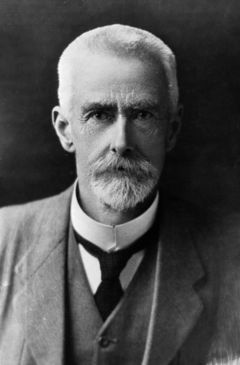
Elsdon Best
Encyclopedia

New Zealand
New Zealand is an island country in the south-western Pacific Ocean comprising two main landmasses and numerous smaller islands. The country is situated some east of Australia across the Tasman Sea, and roughly south of the Pacific island nations of New Caledonia, Fiji, and Tonga...
.
Early life and career
Elsdon Best was born 30 June 1856 at Tawa Flat, New ZealandNew Zealand
New Zealand is an island country in the south-western Pacific Ocean comprising two main landmasses and numerous smaller islands. The country is situated some east of Australia across the Tasman Sea, and roughly south of the Pacific island nations of New Caledonia, Fiji, and Tonga...
, moving with his family to Wellington
Wellington
Wellington is the capital city and third most populous urban area of New Zealand, although it is likely to have surpassed Christchurch due to the exodus following the Canterbury Earthquake. It is at the southwestern tip of the North Island, between Cook Strait and the Rimutaka Range...
at the age of 9, where he went to school. He passed the Civil Service Examination and became a clerk in 1873, but within a year found the work uncongenial and moved to the east coast, where he worked in farming and forestry. In 1881, he joined the Armed Constabulary, but soon left it to travel, visiting Hawaii and then California, where he worked in cattle mustering and lumbering.
In 1886, Best returned to New Zealand, resuming his life in the bush where he came into increasing contact with the Māori, whose language he learned and culture he began to study. When the Polynesian Society
Polynesian Society
The Polynesian Society is a non-profit organization based at the University of Auckland, New Zealand, dedicated to the scholarly study of the history, ethnography, and mythology of Oceania....
was founded in 1892, Best was working in Wellington in a warehouse, and wrote an article on the people of the Philippines and submitted it to the society's new journal. He also began a series on the history of Wellington Harbour.
Work among the Tūhoe
In 1895, when the Urewera districtTe Urewera
Te Urewera is an area of the central North Island of New Zealand. Located in rough, sparsely populated hill country to the northeast of Lake Taupo, it is the historical home of Tuhoe, a Māori iwi known for their controversial stance on Māori sovereignty...
began to be opened up for European settlement, Best took a position as quarter-master with the road works, beginning in Te Whaiti. For the next 15 years, he worked in the district, using his presence in the area to build up a relationship with many Tūhoe elders and record the facts of the culture and traditions of the Tūhoe
Tuhoe
Ngāi Tūhoe , a Māori iwi of New Zealand, takes its name from an ancestral figure, Tūhoe-pōtiki. The word tūhoe literally means "steep" or "high noon" in the Māori language...
, which were still relatively intact. He recorded his observations in field records and note books that he kept now for the rest of his life. His relationship with Tutakangahau is the subject of a recent book.
Best's devotion to his study, together with his facility in Māori, allowed him to win the confidence of the Tūhoe, whose traditions he published in a series of articles in the Transactions of the New Zealand Institute and the Journal of the Polynesian Society. In 1897, he published the monograph Waikaremoana, the Sea of Rippling Waters, With a Tramp through Tuhoe Land, in which he presented the lore of the district.
Ethnologist

Museum of New Zealand Te Papa Tongarewa
The Museum of New Zealand Te Papa Tongarewa is the national museum and art gallery of New Zealand, located in Wellington. It is branded and commonly known as Te Papa and Our Place; "Te Papa Tongarewa" is broadly translatable as "the place of treasures of this land".The museum's principles...
which allowed him to pursue his research in a more focused manner. In 1912, he published The Stone Implements of the Maori, which was followed four years later by an accompanying bulletin on Māori storehouses. In 1919, his The Land of Tara appeared, a history of the Māori of Wellington Harbour. A systematic survey of traditional Māori culture, The Maori, appeared in two volumes in 1924, and in 1925 Best's Tuhoe, the Children of the Mist. This a monumental study in 1200 pages of the traditional history and culture of tribe with which he had spent so much of his life.
In 1914, Best was awarded the Hector Medal of the New Zealand Institute, and in 1919 he was made a fellow.
Best died in 1931 in Wellington, survived by his widow Adelaide (née Wylie). They had no children.
External links
- Works by Elsdon Best (eTexts)
- Dictionary of NZ Biography entry
- Obituary by Te Rangi Hiroa in Transactions of the Royal Society of New Zealand (of which he was a founder member)
- Biography in 1966 Encyclopaedia of New Zealand
- The Land of Tara in Wellington Public Library website
- Best of Tawa new book
- 1921 paper on Old Redoubts, Stockades and Fortifications in Wellington
- Best of Both Worlds

